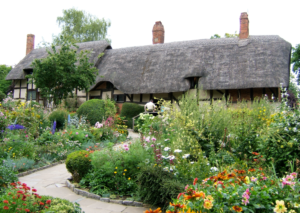Anyone who has ever been in the car with me, driving through a city or suburban area, has been subject to my rant about turfgrass. My friends and family have come to know this argument by heart. I love a nice green lawn as much as the next person, but with pollinator habitat disappearing by the acre and freshwater around the world becoming ever more precious, I can’t help but be a little critical of them. The fact is, a nonnative grass monoculture (area of only one species of plant) of bluegrass or fescue is something of a pollinator desert – offering no larval host plants or flowering food sources. And beyond that, they can take a lot of chemical and water input to keep them green and weed free. There are so many more interesting, attractive and ecologically friendly options for lawn replacement!

Ditching your front yard isn’t a new trend – it was hip in the middle ages too! The historic home of Anne Hathaway (wife of Shakespeare) has a beautiful and diverse front yard cottage garden. England has long been famous for their colorful cottage gardens. By Richard Peat [CC BY-SA 2.0 (https://creativecommons.org/licenses/by-sa/2.0)], via Wikimedia Commons
So Many Reasons, So Little Time
Between homeowner yards, business fronts, and miles of narrow hellstrips along city streets, our love affair with turfgrass runs inexplicably deep. And we have much too much of it here in Kansas – in 2011, Kansas had 495,000 acres of lawn, slightly more than the acreage of wheat but less than our acreage of corn. But there are so many good reasons to rethink our grass obsession and transition to more productive landscapes:
- native grasses/garden provide larval host plants and habitat for overwintering insects
- native plants produce seeds and berries for birds
- deep roots of native plants enrich soil and are resilient against drought
- dense garden spaces provide carbon sequestration and help to cool the air
I won’t tell you transitioning from a lawn to a prairie garden is easy. It takes lots of time and a fair bit of labor. I see it as trading one type of work for another. Instead of mowing every week, you will mow it down once a year. You save money on fertilizers and herbicides, but you spend time planting and weeding. I find gardening much more enjoyable work than traditional ‘lawn care’, and all the less tedious because I know the work is part of responsible resource use and providing habitat.
But even I am not a purist here; I will always have a little bit of grass lawn in my landscape. I have a dog who loves to play frisbee and roll in the grass, so that space gets well used. Additionally, you can use small areas of green grass to give the eye a rest in an otherwise diverse and colorful landscape. There is a whole spectrum of choices: you can go gung-ho and convert all your grassy areas to garden spaces, or you can simply commit to decreasing your square footage of turfgrass while still keeping certain areas for recreation and aesthetics.
Go All In
If you are ready to swear off weekly mowing, regular applications of fertilizer, aeration, and all the other tasks that lead to a perfectly green lawn, consider a total transformation. Who says a garden has to be relegated to a small corner of the back yard? Make your lawn into a pollinator paradise with flowering natives. To keep the space looking organized and intentional, plant in masses or clumps. Following a landscape plan that draws the eye through the landscape with repeated colors and shapes also helps.

This home in Oklahoma has skipped the traditional grass lawn by planting shrubs and perennials around pathways and decorative rocks. The sidewalks keep things looking tidy and also make for easy access to the beds. By Lebuert [CC BY-SA 3.0 (https://creativecommons.org/licenses/by-sa/3.0) or GFDL (http://www.gnu.org/copyleft/fdl.html)], from Wikimedia Commons
Starting Small
Perhaps you, like me, still need some green lawn for your dog or space for a game of horseshoes. There are lots of ways you can decrease your ecological impact and create habitat without giving up your grass completely. Wide grassy pathways with curved edges create a fun, natural looking space that still provides room to play. Alternatively, think about areas of your landscape that are already divided up – do you have a sidewalk or fence that separates one part of your yard from this other? Commit to converting on of those spaces to native garden while the other can remain grass. This method allows you to learn as you go instead of being overwhelmed by an entire yard full of new plant material.
If you are thinking of making changes to your yard, big or small, Dyck Arboretum can provide landscape designs and choose native species that will thrive. The birds and butterflies you attract will be happy to see a yard full of food and color!








